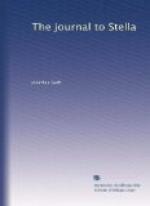11. William Stewart, second Viscount Mountjoy, a friend and correspondent of Swift’s in Ireland. He was the son of one of William’s generals, and was himself a Lieutenant-General and Master-General of the Ordnance; he died in 1728.
12. Catherine, daughter of Maurice Keating, of Narraghmore, Kildare, and wife of Garret Wesley, of Dangan, M.P. for Meath. She died in 1745. On the death of Garret Wesley without issue in 1728, the property passed to a cousin, Richard Colley, who was afterwards created Baron Mornington, and was grandfather to the Duke of Wellington.
13. The landlady of Esther Johnson and Mrs. Dingley.
14. Swift’s housekeeper at Laracor. Elsewhere Swift speaks of his “old Presbyterian housekeeper,” “who has been my Walpole above thirty years, whenever I lived in this kingdom.” “Joe Beaumont is my oracle for public affairs in the country, and an old Presbyterian woman in town.”
15. Isaiah Parvisol, Swift’s tithe-agent and steward at Laracor, was an Irishman of French extraction, who died in 1718 (Birkbeck’s Unpublished Letters of Dean Swift, 1899, p.85).
Letter 2.
1. In some Ms. Accounts of Swift’s, in the Forster Collection at South Kensington there is the following entry:—“Set out for England Aug. 31st on Thursday, 10 at night; landed at Parkgate Friday 1st at noon. Sept. 1, 171O, came to London. Thursday at noon, Sept. 7th, with Lord Mountjoy, etc. Mem.: Lord Mountjoy bore my expenses from Chester to London.”
2. In a letter to Archbishop King of the same date Swift says he was “equally caressed by both parties; by one as a sort of bough for drowning men to lay hold of, and by the other as one discontented with the late men in power.”
3. The Earl of Godolphin, who was severely satirised by Swift in his Sid Hamet’s Rod, 171O. He had been ordered to break his staff as Treasurer on August 8. Swift told Archbishop King that Godolphin was “altogether short, dry, and morose.”
4. Martha, widow of Sir Thomas Giffard, Bart., of County Kildare, the favourite sister of Sir William Temple, had been described by Swift in early pindaric verses as “wise and great.” Afterwards he was to call her “an old beast” (Journal, Nov. 11, 171O). Their quarrel arose, towards the close of 17O9, out of a difference with regard to the publication of Sir William Temple’s Works. On the appearance of vol. v. Lady Giffard charged Swift with publishing portions of the writings from an unfaithful copy in lieu of the originals in his possession, and in particular with printing laudatory notices of Godolphin and Sunderland which Temple intended to omit, and with omitting an unfavourable remark on Sunderland which Temple intended to print. Swift replied that the corrections were all made by Temple himself.
5. Lord Wharton’s second wife, Lucy, daughter of Lord Lisburn. She died in 1716, a few months after her husband. See Lady M. W. Montagu’s Letters.




